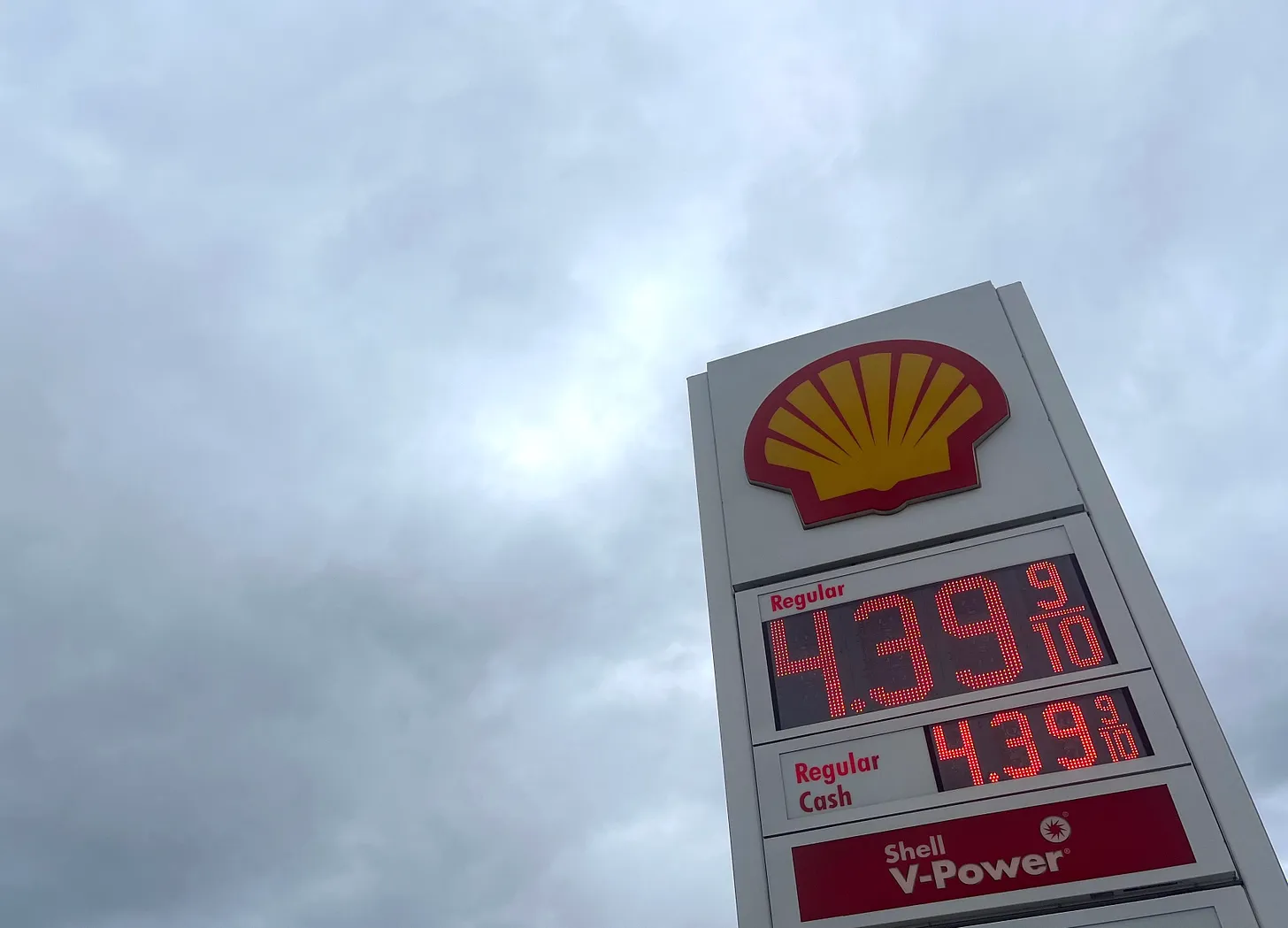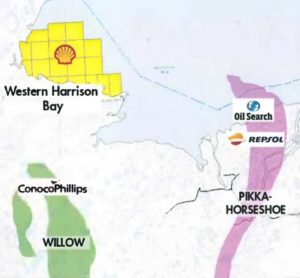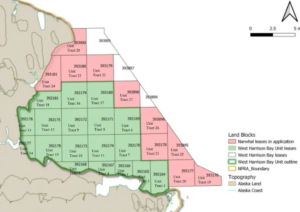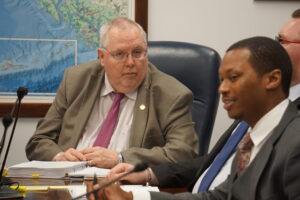
Imagine, for a moment, that you’re the head of a publicly traded oil company.
In your corner office, a team of executives has come to pitch you on a new, possibly lucrative drilling opportunity. It’s in a relatively politically stable country; the local tax regime is reasonable, if not generous. Other companies have found huge deposits in the area, and your own geologists are telling you that there’s likely a whole lot of oil in the ground. You’ve already leased the area.
There’s one big problem, though: The project is in the Arctic, in an undeveloped region of Alaska’s North Slope — and while it’s not in deep water, it’s a slight distance offshore. Which means drilling risks provoking lawsuits and permitting challenges from conservation groups, protests from local whaling captains, maybe even disruptions from climate activists at your next shareholder meeting.
You call up the heads of other multinational oil companies that you sometimes work with to see if any of them want to buy a stake in the project and take the lead on drilling. But they all balk.
So, you take a pass, and hand back to the state what could ultimately be some highly valuable leases. You’ll take your chances drilling somewhere else — probably in a region where you expect to be able to get the oil to market sooner, before there’s too much of a risk of declining global oil demand amid adoption of renewable technologies.
Welcome to Alaska’s future. Or, really, its present.
The details are a bit fuzzy, but this story is not entirely hypothetical. Something like it just happened.
Earlier this month, Shell’s Houston-based U.S. arm said it would relinquish a set of oil leases in an area of the North Slope, West Harrison Bay, that some observers say the company’s own geologists were salivating over. The leases were Shell’s last majority-owned properties in the state, following its decision to give up a batch of federal offshore leases in 2016.
“As a former oil company guy for over 40 years, I have sympathy for those guys in Houston, because I knew it probably drove them crazy that their upper management was so against it — and so scared of the European climate cultists,” said Anchorage Republican Rep. Tom McKay, who convened a legislative hearing about the West Harrison Bay prospect earlier this year.
McKay, a petroleum engineer, said in an interview that he thinks other companies could still acquire the leases at a state auction and drill for oil themselves — including, potentially, an upstart player, Narwhal LLC, that has bought up surrounding acreage.
But Narwhal lacks Shell’s enormous financial wherewithal — a crucial asset when the cost of drilling wells in remote parts of the North Slope can top $100 million.
Other industry players say that Shell’s exit from the state is an important and unsettling symbol of the economic future for oil-dependent Alaska: As the world looks toward lower-carbon energy sources in response to global warming, some of the state’s hard-to-tap petroleum prospects are becoming less attractive.
The exit of Shell — one of the first major companies to operate in Alaska — follows the departure of other major companies from the state, including BP in 2020.
“A lot of stuff is coming together that suggests decreased investment in remote, Arctic areas for oil and gas. Alaska leadership has to understand this stuff is happening,” said Mark Myers, a former state natural resources commissioner who also once led the U.S. Geological Survey. “Worldwide events are overcoming us faster than we can manage it. Shell’s response should not be seen as a one-off.”

The end of oil and gas is still far off in Alaska, where taxes and royalties from the industry amount to slightly more than one-third of the state government’s unrestricted revenue.
Two huge new oil projects are currently under construction on the North Slope, and could collectively boost Alaska’s overall production by some 50%.
But the new Pikka development, now owned by Australian company Santos, was delayed for years amid concerns from investors about backing a project in the Arctic. And ConocoPhillips’ new Willow project has faced a slew of lawsuits and intense, broad opposition from conservation groups and climate advocates.
Shell acquired its West Harrison Bay leases in 2012 — the same year the company began a much higher-profile drilling quest in the Chukchi and Beaufort seas offshore of Alaska. That unsuccessful multiyear campaign, in federal waters, was marked by the wreck of one of Shell’s offshore drilling rigs.
The drilling ultimately cost the company $7 billion, but never produced a barrel of oil for sale.
In the wake of that failure, and amid fierce lobbying by activists against Arctic oil development, the company said a few years later that it would not pursue any new remote exploration leases in the region.
But it quietly held on to its 125 square miles in West Harrison Bay, in the state waters just offshore of the National Petroleum Reserve – Alaska.
The deposit is north of ConocoPhillips’ Willow project, and just to the west of Santos’ Pikka development. And Shell, in correspondence with the Alaska Department of Natural Resources in 2020, said it had identified several potential oil and gas accumulations and prospects.

But to confirm the presence of commercially viable oil deposits, Shell would have to drill wells. In 2020, the company took an initial step in that direction, merging its 18 leases into a single unit.
But Shell, in its correspondence with the state, indicated that it did not want to drill the wells itself. Instead, it was searching for another business to buy a stake in the leases, take on some of the “risk and cost” associated with the area’s development and begin an exploration campaign.
Shell said its efforts were hindered by the coronavirus pandemic. Through September 2023, it told the state that it was still having “ongoing discussions with its global contacts,” but finally, earlier this month, the company said it had been “unable to secure a suitable co-owner” and would surrender the West Harrison Bay leases.
“The Arctic is such a tough optic for a large international oil company. You can’t have an annual meeting without someone saying, ‘Increase your profits, but by God, don’t do it in the Arctic,’” said a person familiar with the decision, who requested anonymity due to the sensitivity of the deliberations. They added: “It’s not that there’s no oil there.”
In an emailed response to questions, a Shell spokeswoman, Cynthia Babski, did not directly identify the obstacles to finding a partner, saying only that the company had been “actively seeking a co-owner and operator” for several years but ultimately was unsuccessful.
Babski declined to address McKay’s comments about the “climate cultists,” and also did not directly answer a question about why Shell did not seek to sell the leases rather than return them to the state.
“After discussions with the Alaska Department of Natural Resources and other stakeholders, Shell chose to terminate the unit and relinquish the leases,” she said.
That choice could have repercussions for Narwhal, a small, privately owned oil company whose majority stakeholder is a Texas-based family partnership, according to corporate filings with the state.
Narwhal’s leaders include a former Shell employee who worked on the company’s West Harrison Bay development plans. And Narwhal owns more than a dozen of its own leases in the bay that surround the area formerly leased by Shell — though it also hasn’t done any drilling.

For the past two years, Narwhal has pushed Republican Gov. Mike Dunleavy’s administration to pressure Shell into advancing its drilling efforts in West Harrison Bay. It also said in 2022 that Shell had “summarily dismissed” at least a half-dozen of Narwhal’s formal proposals, since 2016, to either jointly drill for oil in the area, or to buy Shell’s leases outright.
Narwhal officials did not respond to requests for comment, and Babski declined to comment on Narwhal’s assertions. But now, if Narwhal wants to buy the leases formerly held by Shell, it will have to win them at an upcoming auction held by the natural resources department, which officials say could happen as soon as later this year.
“The department understands this area to be highly prospective,” said John Crowther, the department’s deputy commissioner.
One major problem for any oil company that ends up finding oil in West Harrison Bay is getting it out.
The land surrounding the nearshore leases relinquished by Shell is all within the National Petroleum Reserve, where the Biden administration just finalized new limits on oil and gas infrastructure and development.
Industry observers say that building a new pipeline from West Harrison Bay across the petroleum reserve and east to connect back to the trans-Alaska pipeline could be difficult, if not impossible, to secure environmental permits for. Crowther and others suggested that perhaps a pipeline could stay offshore, in state waters, until it connects back to state-owned land, where permitting is more industry-friendly.
The big question now is whether any company can secure the investment needed to take up such challenges.
Myers, the former natural resources commissioner, said he thinks that permitting and political impediments have become an increasing problem for Arctic projects, given that oil developments in other areas can often be brought online more quickly.
“You have to look at the time it takes you to permit and develop, even if you’re successful. How does that play into the timing of when we start decreasing oil demand in the world?” he said. “Before, if I sit on it for 20 years, it’s worth hanging onto because there’s always going to be a market for it in the future. Now, oil is systematically being replaced for many of its uses. You’re looking at a different opportunity in the future.”
Myers is worried enough about Alaska’s post-oil economic future that he’s currently investigating whether the state might hold economically valuable underground deposits of a carbon-free fuel: hydrogen.

Dunleavy, the governor, is also hosting a sustainable energy conference this week. But some lawmakers remain deeply skeptical about the need to reposition the state’s economy.
McKay, the Republican state representative, noted that the Alaska Legislature just passed a bill that could help sustain the state’s oil and gas industry by allowing companies to sequester carbon pollution underground.
He also dismissed federal conclusions and the broad scientific consensus about the far-reaching and worsening effects of climate change.
“It’s all emotion. You can’t spend trillions of dollars on something that’s based on emotion,” he said. “I’m just not ready to surrender our oil and gas business.”
Nathaniel Herz welcomes tips at natherz@gmail.com or (907) 793-0312. This article was originally published in Northern Journal, a newsletter from Herz. Subscribe at this link.




